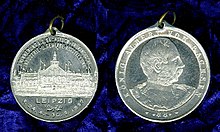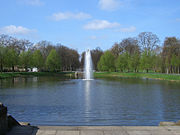Saxon-Thuringian Industry and Trade Exhibition Leipzig 1897
From April 24 to October 19, 1897, the Saxon-Thuringian industrial and commercial exhibition took place in Leipzig as a comprehensive exhibition of Central Germany , combined with a high proportion of popular entertainment.
The occasion
1897 was the 400th anniversary of the awarding of the imperial trade fair privilege for Leipzig Empire Exhibition by the Roman-German king and later Emperor Maximilian I (1459-1519). This occasion was to be used to give the Leipziger Messe a new impetus after the transition to the sample fair in 1895 , as there was also a threat of competition from Berlin in particular , which was preparing to also host a sample fair and had set a warning sign with the Berlin trade fair in 1896. With the inclusion of the Thuringian , Saxon- Ernestine duchies, the aim was to commemorate the once undivided Electorate of Saxony . Exhibitors from the Duchy of Anhalt , the Prussian provinces of Saxony and Brandenburg (with the exception of Berlin), the administrative district of Liegnitz of Silesia and the three Franconian districts of Bavaria were also invited . The Saxon King Albert (1828–1902) took over the patronage of the exhibition. Preparations began as early as 1894, as 1895 had already been envisaged as the year of the exhibition.
The exhibition
An area of 40 hectares west of the newly created music district and the Johannapark was chosen as the exhibition area , which stretched on both sides of the Elster flood bed (at that time still Pleisseflood bed ). The chief architect of the exhibition was Arwed Roßbach (1844–1902), who had already erected a number of important buildings in the music district. The construction management was the well-known architects Heinrich Tscharmann (1859-1932), Hans Enger (? -?), August Hanemann (1840-1926), August Hermann Schmidt (1858-1942), Arthur Johlige , (1857-1937) and Fritz Drechsler (1861-1922) transferred.
Starting from the confluence of Beethovenstrasse and Karl-Tauchnitz-Strasse , an avenue with a bridge over the Pleißeflood bed to the 40,000 square meter main exhibition hall, the industrial hall, was laid out as the central axis of the site, the König-Albert-Allee (today Anton- Bruckner-Allee). The main entrance to the site at the beginning of today's Anton-Bruckner-Straße (roundabout Karl-Tauchnitz-Straße) was flanked by two mighty white columns. Up to the bridge crossing there was a large number of other exhibition halls, such as the agricultural hall, the horticultural hall, the textile hall, the gas and water hall, the bicycle hall, a pavilion of the city of Leipzig, halls for individual companies and an art hall. A total of 3027 exhibiting companies took part.
For the art exhibition, a jury selected 864 works of art by 362 Saxon and Thuringian artists. In addition to paintings and sculptures, architectural designs were also represented. The controversial highlight of the exhibition was Max Klinger's monumental painting Christ in Olympus , which was presented to the public for the first time.
The replica of medieval Leipzig buildings in original size with the old town hall , Auerbachs Hof and the Naschmarkt , a Thuringian village with a church, mill, inn and farms, a so-called Tyrolean mountain trip and a "colonial exhibition" with a replica of a trade route in Dar es Salaam was designed for show value and an African native settlement that was populated by over 50 Bantu people. Artificial ponds had been created both in the middle of König-Albert-Allee and south of it. The latter had a colored illuminated fountain in the middle . The main restaurant, the main café (Viennese café) and the pub district are grouped around it. It had its own theater and a fairground (entertainment district). The whole area could be circled with a small train pulled by an electric locomotive.
Behind the main exhibition hall were the facilities of the site. A separate power station provided the electricity. Own steam and water supply networks were available. All buildings and facilities were built exclusively by Saxon and Thuringian companies.
- Postcards from the exhibition
After that
When the exhibition closed, they had seen 2.4 million visitors. The total costs of 2.1 million marks (1.7 million marks from donations from the citizens) had thus paid off. It was the biggest exhibition Leipzig had ever seen. The further development of the fair had also received the desired impetus.
The buildings, which had been built in a lightweight construction just for the exhibition, were all torn down again. In 1899, the newly created park on the former site of the trade exhibition was given the name "König-Albert-Park". Anton-Bruckner-Allee and the two ponds are still direct witnesses to the exhibition. From the debris left over from the exhibition, two mounds were formed in the middle part, which are integrated into today's park, the Leonorenhügel or “Kleine Wart” (110.5 meters above sea level ) between Franz-Schubert-Platz and the former horticultural hall of the exhibition, and the "Warze" or "Big Warze" (112.5 meters above sea level) opposite the island pond at the location of the former theater. Today both serve as toboggan slopes.
One building, however, still exists. In the pub district of the exhibition there was the Blockhaus restaurant, which was also built as such and was operated by the Leipzig brewery FA Ullrich . After the end of the exhibition, this brewery converted the log house into the allotment garden association “Westvorstädtischer Schreberverein zu Leipzig- Kleinzschocher ” on Diezmannstrasse, where it still functioned as such until the 1980s, after which it served as the premises of the allotment gardening board . The allotment garden association has been called "Blockhaus" since 1934.
- Leftover from the exhibition
See also
literature
- 120 years industrial and trade exhibition Leipzig 1897-2017 , two special editions of the Musikpavillon -Journal 2017, (online)
- Hans-Christian Mannschatz: The Saxon-Thuringian industrial and trade exhibition Leipzig 1897. In: The Leipzig music district. Verlag im Wissenschaftszentrum, Leipzig 1997, ISBN 3-930433-18-4 , pp. 78-80
- Enrico Hochmuth: The problem of the industrial and commercial exhibition system and the history of museums. The example of the Saxon-Thuringian industrial and commercial exhibition in Leipzig in 1897 . In: Katharina Flügel and Frank-Dietrich Jacob (eds.), Curiositas. Journal for Museology and Museum Source Studies, No. 1, Langenweißbach and Leipzig 2001, pp. 137–165.
- Enrico Hochmuth: The industry and trade exhibition 1897 and selected cartographic sources. In: Stadt Leipzig / Stadtarchiv Leipzig (ed.), Leipziger Calendar (special volume: Leipzig in the map), 1, Leipzig 2001, pp. 89–94.
- Enrico Hochmuth: "... A picture of the state of the domestic industry and artist industry" On the history of the industrial and commercial exhibitions in Leipzig in the 19th century. In: Katharina Flügel and Frank-Dietrich Jacob (eds.), Curiositas. Journal for Museology and Museum Source Studies, Langenweißbach u. Leipzig 2005, pp. 47-60.
- Enrico Hochmuth: Industrial and commercial exhibitions in Saxony 1824-1914. Your contribution to regional and communal location development , Saxon Economic Archives (ed.), Volume 9, Series A: Contributions to the economic history of Saxony, Sax-Verlag, Markkleeberg 2012.
- Enrico Hochmuth: Seffner great! Klinger hideous! The art exhibition at the Leipzig industrial exhibition in 1897. In: Leipziger Blätter , No. 41 (2002), p. 54.
- Enrico Hochmuth: From the jungle hut to the glass house. In: Leipziger Blätter , No. 39 (2001), pp. 29–31
- Official guide of the Saxon-Thuringian industrial and commercial exhibition in Leipzig 1897. GL Daube & Co., Leipzig 1897.
- Saxon-Thuringian Industry and Trade Exhibition Leipzig 1897. (Photo album) Meisenbach, Riffarth & Co., Leipzig 1897.
Web links
Individual evidence
- ↑ 120 years of the Leipzig industrial and trade exhibition 1897–2017. Part 1, p. 3
- ↑ Enrico Haughty: From the jungle hut to the glass house. P. 29.
- ↑ Enrico Hochmut: Seffner great! Klinger hideous! ... p. 54.
- ↑ Hans-Christian Mannschatz: The Saxon-Thuringian Industry and Trade Exhibition ..., p. 80
- ↑ 120 years of the Leipzig industrial and trade exhibition 1897–2017 . Part 1, p. 2
- ↑ Leipziger Volkszeitung of February 5, 2010, p. 19.
Coordinates: 51 ° 19 ′ 47.9 ″ N , 12 ° 21 ′ 10.3 ″ E
















